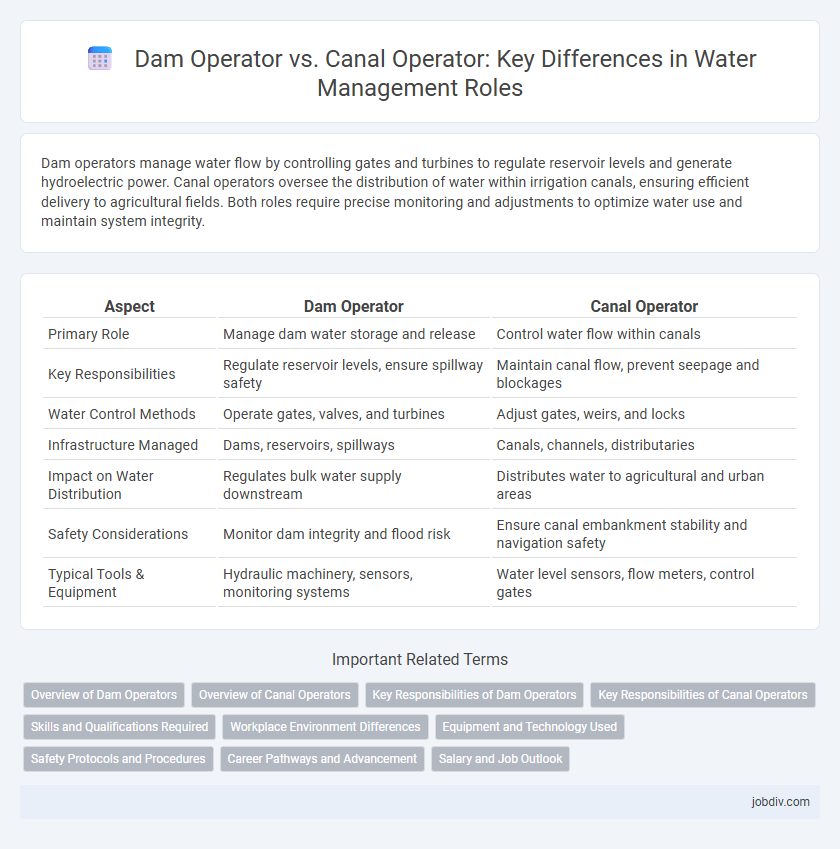Dam operators manage water flow by controlling gates and turbines to regulate reservoir levels and generate hydroelectric power. Canal operators oversee the distribution of water within irrigation canals, ensuring efficient delivery to agricultural fields. Both roles require precise monitoring and adjustments to optimize water use and maintain system integrity.
Table of Comparison
| Aspect | Dam Operator | Canal Operator |
|---|---|---|
| Primary Role | Manage dam water storage and release | Control water flow within canals |
| Key Responsibilities | Regulate reservoir levels, ensure spillway safety | Maintain canal flow, prevent seepage and blockages |
| Water Control Methods | Operate gates, valves, and turbines | Adjust gates, weirs, and locks |
| Infrastructure Managed | Dams, reservoirs, spillways | Canals, channels, distributaries |
| Impact on Water Distribution | Regulates bulk water supply downstream | Distributes water to agricultural and urban areas |
| Safety Considerations | Monitor dam integrity and flood risk | Ensure canal embankment stability and navigation safety |
| Typical Tools & Equipment | Hydraulic machinery, sensors, monitoring systems | Water level sensors, flow meters, control gates |
Overview of Dam Operators
Dam operators manage the controlled release of water from reservoirs to regulate river flow, support irrigation, and generate hydroelectric power. They monitor water levels, mechanical systems, and weather conditions to prevent flooding and maintain structural safety. Their role is critical in ensuring efficient water distribution and protecting downstream communities.
Overview of Canal Operators
Canal operators manage the distribution of water through a network of canals, ensuring regulated flow for irrigation, municipal, and industrial use. Their responsibilities include monitoring water levels, operating gates and valves, and maintaining canal infrastructure to optimize water delivery and minimize losses. Effective canal operation is critical for sustaining agricultural productivity and water resource management in regions dependent on surface water distribution.
Key Responsibilities of Dam Operators
Dam operators manage water flow by controlling gate openings and reservoir levels to ensure flood control, hydroelectric power generation, and irrigation supply. They monitor structural integrity, perform routine inspections, and respond to emergency situations to maintain dam safety. Precise water release coordination with downstream water users and regulatory compliance are critical elements of a dam operator's responsibilities.
Key Responsibilities of Canal Operators
Canal operators manage the controlled distribution of water through irrigation canals, ensuring optimal water flow and preventing losses due to leakage or unauthorized use. They monitor water levels, operate gates and valves, and coordinate maintenance activities to sustain canal integrity and efficient water delivery to agricultural lands. Their role is critical in regulating water supply schedules aligned with crop requirements and minimizing water wastage across canal networks.
Skills and Qualifications Required
Dam operators require strong technical skills in hydraulics, mechanics, and electrical systems, often needing certifications in dam safety and water management. Canal operators focus on skills in water flow regulation, irrigation systems, and maintenance of canal infrastructure, typically holding qualifications in agricultural engineering or water resources management. Both roles demand keen attention to safety protocols, real-time monitoring abilities, and understanding of environmental regulations.
Workplace Environment Differences
Dam operators typically work in controlled facilities with advanced monitoring systems, managing water flow and reservoir levels, often in isolated or remote locations requiring shift work and vigilance for safety risks. Canal operators are frequently outdoors, maintaining and operating canal gates and pumps while monitoring water distribution across agricultural or urban regions, facing exposure to weather conditions and physical labor. These distinct environments impact the operators' daily routines, job demands, and safety protocols significantly.
Equipment and Technology Used
Dam operators utilize advanced hydrological sensors, automated gate control systems, and SCADA technology to monitor water levels and regulate reservoir flow precisely. Canal operators rely on remote sensing tools, flow meters, and computerized irrigation scheduling software to manage water distribution efficiently across irrigation networks. Both roles integrate GIS mapping and real-time data analytics to optimize water resource management and ensure operational safety.
Safety Protocols and Procedures
Dam operators implement rigorous safety protocols including regular structural inspections, emergency spillway management, and real-time monitoring of water levels to prevent dam failure and downstream flooding. Canal operators follow strict procedures for water flow regulation, lock operation safety, and maintaining clear communication to avoid accidents and ensure safe navigation. Both roles require adherence to safety standards set by regulatory bodies to protect infrastructure, personnel, and surrounding communities.
Career Pathways and Advancement
Dam operators often start as entry-level technicians and advance through certifications in hydraulic engineering and safety management, enabling roles in project supervision or facility management. Canal operators typically progress from field maintenance positions to control room operations, with opportunities to specialize in water distribution systems or irrigation management. Both career pathways benefit from experience in water resource management, but dam operators generally have broader advancement prospects due to the complexity and scale of dam infrastructure.
Salary and Job Outlook
Dam operators earn an average salary ranging from $50,000 to $70,000 annually, reflecting the specialized skills required for managing large-scale water containment and hydroelectric systems. Canal operators typically have a lower salary range, around $35,000 to $55,000 per year, due to the localized nature of their work involving waterway management and irrigation systems. The job outlook for dam operators is projected to grow moderately by 5% through 2030, driven by infrastructure maintenance needs, while canal operators face stable employment prospects with minimal growth tied to agricultural and municipal water management demands.
Dam Operator vs Canal Operator Infographic

 jobdiv.com
jobdiv.com